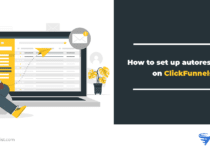How to sell multiple courses with ClickFunnels

Online courses are a trend nowadays simply because it’s convenient to teach and learn online from the comfort of your own home or wherever in the world you wish to be.
Subject matter experts become online lecturers when they create curriculums to teach others what they know using the internet. A typical online course will mostly consist of e-books, scheduled tasks, and activities based on different topics.
Selling online courses can be a good business. Unlike in real life education settings, capacity won’t be a problem. You can have as many people enrolled in your courses as you want. Setting up a course can be a piece of cake, but what can help make your course successful is a good platform that can do more than just host your courses.
ClickFunnels is a pioneer in the course platform. So many lecturers have published hundreds of courses online through it. (READ: How to host online courses on ClickFunnels)
Get our FREE course on funnel building and marketing. We'll deliver it straight to your inbox! Learn about how to build and market your funnels for your business. The course includes a full tutorial on how to use ClickFunnels.![]()
Planning your course can be easy… until you have to make it to reality. In planning, you must consider several factors such as general audience, method of the session, and so much more. Lucky for you, this is something that ClickFunnels is good at.
Overview of ClickFunnels
Initially, SaaS (Software as Service) ClickFunnels‘ primary focus is funnel building. Funnels are workflows made for eCommerce. It’s a sequence of triggers that when done right, can convert visits to sales.
ClickFunnels is a good marketing and sales tool. However, ClickFunnels is more than sales funnels. It’s a hub for many eCommerce possibilities and is an excellent match for any type of online entrepreneur. (READ More: Everything you need to know about ClickFunnels)
Benefits of ClickFunnels: Basic Tools and Functions
ClickFunnels is great at building effective funnels, which can be used to everyone’s advantage. Courses? Services? Businesses? Corporations? You name it, funnels can be beneficial to you.
Here are some of ClickFunnels’ basic features:
- Customizable Domains
- Analytics
- A/B Split Tests
- Email Integrations
- All Advanced Funnels
- Sales Funnels
- Membership Funnels
- Auto Webinar Funnels
- Webinar Funnels
- Hangout Funnels
- Page Builder
- Order Pages
- Upsell Pages
- Downsale Pages
- Customer Support
- Third-Party Program Integrations
The sales funnel, in particular, can be great for converting buyers. If used properly, you can turn these buyers into consumers or in your case, interested viewers into enrolled students.
Course-Building in ClickFunnels: Step by Step
Building a course is easier said than done, especially if you don’t have any idea what you’re doing or where to begin.
First, to build a useful course, you must put a concept together around the subject you wish to teach. The concept should include the following:
- Type of Service
- Host of Session
- Group of Personnel for Management
- Business Type
- Target Audience or Demographic
- Sales Method
- Initial Merchandise or Product
- Main Intent of the Business
Other things necessary in setting up your course include:
- Sales Funnel – The primary weapon, which will help you expose and convert visitors to your course.
- Build a Front-End Page with ClickFunnels’ Page Builder.
- Landing Pages are the frontrunner. Luckily, the software offers pre-made templates.
- Organize your Shopping Cart System
- This will automatically fix your sales in no time: process payments and transactions with ease.
- Control contacts with Email Marketing
- It directs successful contacts to your email list. Constant engagement can be a great thing in business.
- Compel new and former consumers to participate in your market.
- Build a Front-End Page with ClickFunnels’ Page Builder.
Once collected, you can pretty much start building your course. Do the following:
- Go to your ClickFunnels account dashboard.
- Once done, click Build Funnel and choose to Sell your Products
- You’ll be offered 3 choices. But since courses are the highlight, we’ll be picking Membership. (NOTE: To host your own course, it would be best to sign up for the Membership Site.)
o Sales Funnel
- Sell products directly from your landing pages
o Product Launch
- launch sales through a sequence of product launch
o Membership
- Limit your resources to the chosen audience and charge each service
- Name the said Membership course based on its concept.
- Next, you’ll be directed onto the creative process. This applies to the Membership Access, Membership Area
- Here, the software will present templates that suit best to your needs.
- Preview each template, pick the best one for you and edit it to your liking.
- Membership Access is the sign-up process of potential prospects.
- Membership Area is the lounge for your audience.
- As you start to edit, you’ll be allowed to add the following:
- Access Restrictions
- Add Extra Segments
- Add or Remove Lessons and Contents
- Edit the Design of the Funnel (Font, Color, Wallpaper, Logo, and Texts)
- Correct your Lessons
- Once done editing, click Add New Funnel Steps if you wish to add pages or forms to your membership funnel.
- When you’re done setting up, launch your course/s.
- Check your funnel and monitor your registered “students.”
- Monitor the status with the analytics.
With ClickFunnels, most of the work is pretty much done for you. The only thing you really need to worry about is the content of your course and funnel. (READ MORE: How to create an online course with Clickfunnels)
ClickFunnels’ Funnel Types:
Funnels come in different types and are tailored to a specific business to help them grow better. Keep in mind that courses too can be about anything, depending on the user’s expertise, wants or needs.
- Sales Funnels
- These integrate your courses into physical products. It can project sales by launching these as merchandise. Direct potential customers to business sites, build your contact lists as well.
- Membership Funnels
- Membership funnels are made for online courses. Since courses contain activities, lectures, and learning sources, you can limit registered users’ access by charging them before they can access any more information.
- Put out online curriculums based on your audience’s interest. Build a huge following through tutorials.
- Webinar Funnels
- Webinar Funnels are made to host live sessions online. These are great for demonstrative courses. You can interact virtually but with mobile technology.
- Conduct webinar sessions, convert them into video tutorials and sell each session. Charge this information online.
As you can see, each funnels’ method is inclusive but also flexible. It has corresponding contents to fit specific business types.
Course types: Great content equals greater feedback
Not all course types are on-trend. The most in demand courses today include:
- Art Workshops
- Culinary Arts
- Consultation Specialists
- DIY Workshops
- Blogging
- Content Creators
- Personal Development workshops
- Leadership Training
- Audio Arts (Music and SFX Workshops)
- Beauty and Fashion Ateliers
If your concept fits one of these topics, we recommend that you waste no time in creating your online course.
Almost anyone can use ClickFunnels. Although it’s not a dedicated hosting site for courses, unlike Teachable and Thinkific, it can still do the job… and more! Not only is it a tool that can host your courses, it’s also an all-in-one marketing platform. Its sales funnels make up for what it lacks, and by utilizing them, you can sell multiple courses at a time fast and with not much fuss. (READ: How to get started with ClickFunnels)


